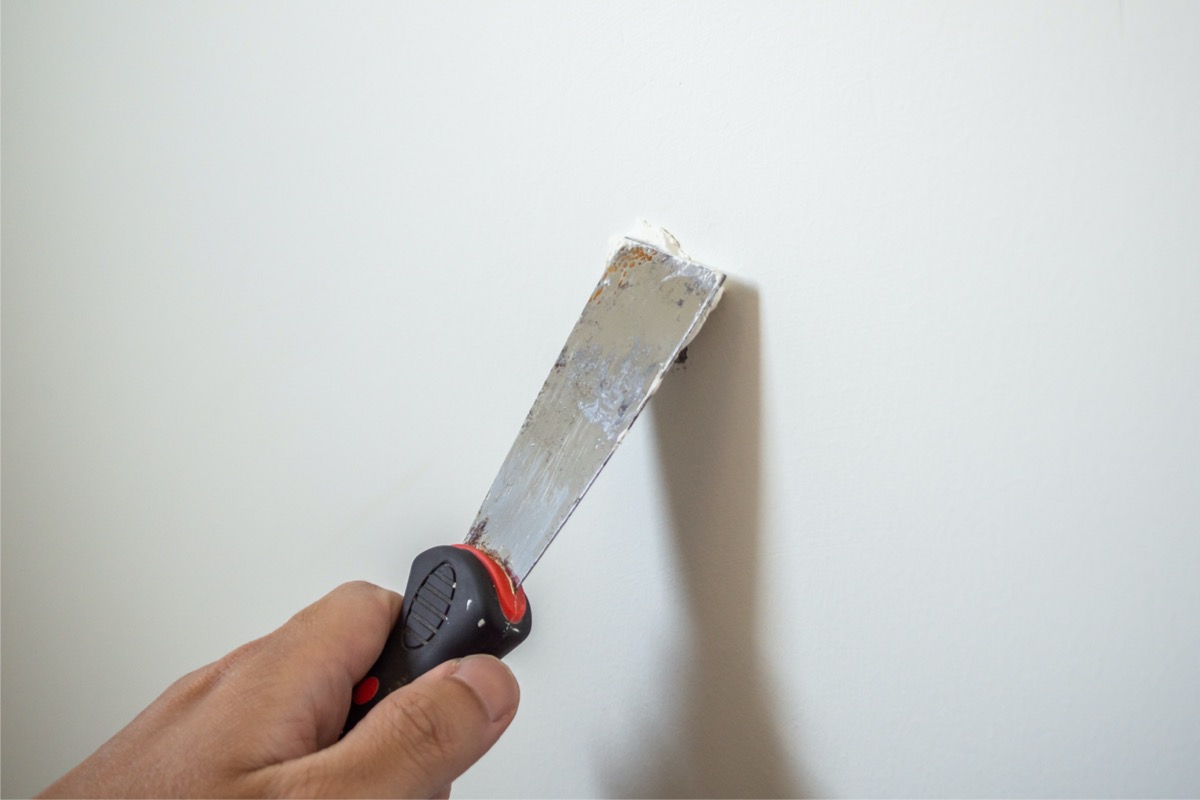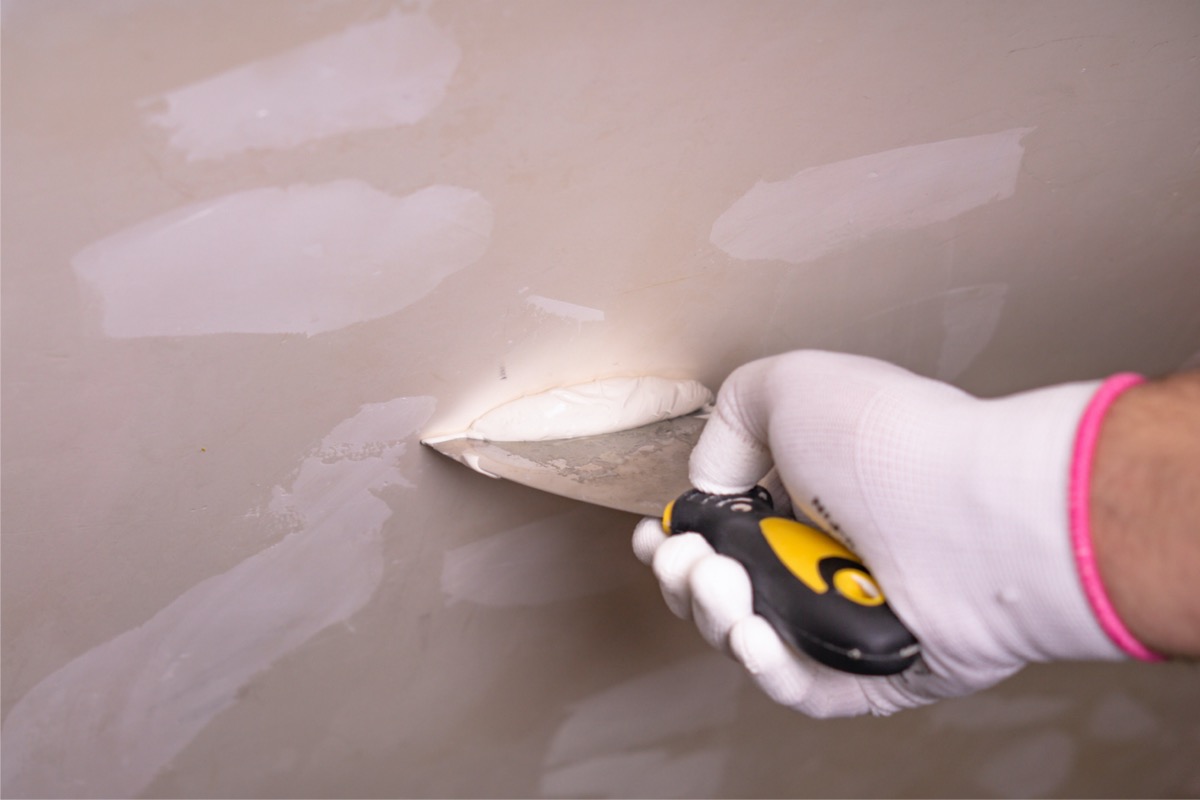We may earn revenue from the products available on this page and participate in affiliate programs. Learn More ›
Q: I recently moved into a new fixer-upper home. There are several spots on the walls and ceilings that need repair, and I want to factor spackle dry time into my sanding and painting plans. How long does spackle take to dry?
A: Learning how to spackle drywall is important for patching holes and filling gaps, but you need to let the drywall spackle set, dry, and cure before sanding for the best results. On average, most spackle takes about 1 to 2 hours to dry and around 24 hours to fully cure.
However, your specific spackle may dry more slowly or quickly depending on several factors. To answer the question, “How long does it take spackle to dry,” you need to consider the type of spackle you’re using, the size of the needed repairs, and any environmental factors that can slow the drying time.
RELATED: Joint Compound vs. Spackle: What’s the Difference?
It depends on the type of spackle you use.
There are various types of spackle, including standard, epoxy, acrylic, vinyl, and quick-dry spackle, each with different drying times.
When you are learning how to spackle, it’s important to understand which spackle type is best-suited for a task. You’ll then know which spackle is best for small drywall holes, larger repairs, and even patching masonry.
Standard: The most common type of spackle is a gypsum-based solution that can be used on small-to-large holes and cracks in drywall. Standard spackle is a premixed paste that can be applied directly to the wall or ceiling you want to patch.
After application, allow the spackle to set and dry for at least 2 hours, but check the manufacturer’s recommendations for an exact drying time. While the average spackle may have a 2-hour drying time, there may be slight differences between brands, and that’s true for every type of spackle.
Epoxy: If you need to repair large holes, fractures, or cracks, epoxy spackle is a great option because it has a higher adhesive strength and longevity than other types of spackle. The drawback is that an epoxy spackle can take up to 24 hours to dry and fully cure before it’s ready to be painted.
Acrylic: Acrylic spackle is a good choice for fixing deep gashes and gouges in drywall, wood, brick, plaster, and stone. It doesn’t deform or crumble after it dries, making it a versatile option for serious repairs. Just make sure to let acrylic spackle dry for about 2 to 4 hours.
Vinyl: Vinyl spackle is similar to acrylic spackle, so it can be used for drywall, wood, cement, rock, and brick repairs. This versatility is possible thanks to the spackle’s elastic polymers, though it also means this type of spackle takes about 2 to 5 hours to dry, depending on the size of the repair and environmental factors, such as temperature and humidity.
Quick-Dry: When you don’t have much time and are only dealing with light drywall damage, a quick-dry spackle solution may be your best bet. Powder quick-dry spackle needs to be mixed with water before use, but it can dry in minutes after application. If you opt for a premixed quick-dry spackle, then you will usually need to let it dry for about 30 minutes.

The size of the repair affects spackle dry time.
Even if you know the characteristics of your spackle, the questions of how long should spackle dry before painting and how long should spackle dry before sanding still remain. The answers to both matters are dependent on the amount of spackle you use, as it may increase the time needed for the repair to dry.
An exaggerated example would be to compare the time it takes a coat of paint to dry versus the time it takes for an open paint bucket to fully dry. Obviously, the single coat of paint will dry faster because there is much less paint spread over a wider surface.
So, if you patch a screw hole in drywall, this minor repair will take less time to dry than if you need to use half a container of spackle to patch a large hole. Additionally, if spackle is used for a broad, shallow repair, it will dry faster than the same amount of spackle used in a deep divot or gouge. This is because more of the spackle is exposed to the open air when it’s spread over a large surface.
Temperature, humidity, and air circulation can affect how long it takes spackle to dry.
You should also weigh several key environmental factors into spackle drying time, which include the worksite’s temperature, air circulation, and humidity. Try to make your repairs when the temperature will fall within the range of about 50 to 90 degrees Fahrenheit, otherwise the spackle may dry more slowly. If you’re working indoors, this should be easy to control, but it may not be so simple for outdoor repairs.
It’s similarly important to take humidity into consideration. If your project space has a high level of humidity, then it will take longer for water in the spackle to evaporate into the air. Drying times in a humid environment can be improved by increasing the air circulation in the area. You can open a window or door and set up a fan to help promote better airflow.
RELATED: Budget Guide: How Much Does Drywall Installation or Replacement Cost?

How to Make Spackle Dry Faster
You may occasionally need to speed up a project in order to meet a deadline. Luckily, there are several simple and effective methods when it comes to how to make spackle dry faster.
Set up a dehumidifier in the area.
High humidity can increase how long it takes spackle to dry, so using a dehumidifier to decrease the humidity level by removing excess moisture from the air can speed up the drying process. Just keep in mind that a dehumidifier isn’t a practical option for outdoor repairs.
Use an air conditioner to reduce the drying time.
Similar to dehumidifiers, an air conditioner won’t help with outdoor repairs, but it can help to dry spackle indoors. Cold air holds less water vapor than hot air, so air conditioners can remove a significant amount of excess moisture from the air by cooling a space, allowing spackle to dry faster.
A fan can improve the air circulation in the room.
Hopefully, there is a nice breeze if you are working outdoors. For indoor repairs or on hot, humid days with very little wind, though, you can set up one or more fans to reduce spackle drying time. By circulating the air throughout an area, moisture in the spackle can evaporate at a quicker rate.
Rely on a blow dryer for minor repairs.
Small repairs won’t usually need a dehumidifier or an air conditioner to reduce drying time, but you still can’t proceed until the spackle is fully dry. Instead of a fan, try using a blow dryer’s cool temperature setting to speed up the time required for a minor repair to fully dry.


